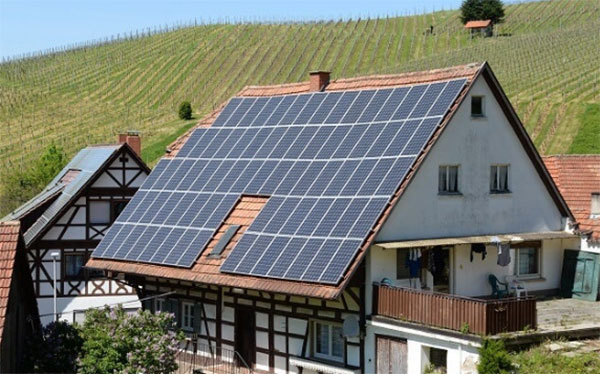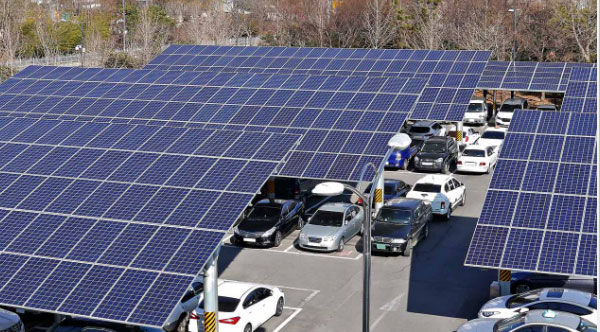Description
Solar panels can provide power during outages if equipped with battery storage and a properly configured inverter system.

Role of Solar Panels in Energy Supply
Solar panels play a crucial role in providing an alternative and sustainable energy source. During power outages, solar panels can continue to generate electricity as long as they receive sunlight. The energy supply from solar panels largely depends on the
solar panel's capacity and the
intensity of sunlight. On average, a residential solar panel system can produce between 250 to 400 watts per hour under full sun.
Factors Affecting Solar Panel Energy Supply
- Sunlight Availability: The efficiency of solar panels drops significantly during cloudy or rainy days, reducing the energy supply.
- Panel Capacity: Residential solar panels usually have a capacity of 1 kW to 4 kW, determining the maximum energy they can produce.
- System Configuration: The setup, including the angle and positioning of solar panels, impacts the energy absorption and, subsequently, the energy supply.
Limitations of Solar Panels During Outages
While solar panels are beneficial, they have certain limitations during power outages, especially if the system is not equipped with a battery backup.
Dependency on Inverters
- Inverter Functionality: Solar panels generate DC power, but most homes require AC power. Inverters play a crucial role in this conversion. During a power outage, if the inverter is not functioning or if it's not a hybrid/inverter with backup capabilities, the solar panels might not supply power to the home.
Need for Battery Storage
- Storage Capability: Without a battery storage system, the energy produced by solar panels during the day cannot be used at night. The cost of battery storage systems varies, with a typical range of $200 to $15,000, depending on capacity and technology.
Environmental Influence
- Weather Conditions: Solar panel efficiency can decrease up to 25% during overcast conditions. In areas with frequent power outages due to storms or heavy cloud cover, reliance on solar panels might be challenging.

Essential Components for Solar Panel Efficiency in Outages
Importance of Battery Storage Systems
Battery storage systems are pivotal for maintaining energy supply during power outages. They store excess power generated by solar panels during the day for use at night or during an outage.
Key Characteristics of Battery Storage Systems
- Capacity: Measured in kilowatt-hours (kWh), capacities typically range from 5 kWh to 15 kWh for residential systems. The right capacity depends on the household's energy needs and the solar system's size.
- Lifespan: Modern lithium-ion batteries can last for 10-15 years or about 3000 charge cycles. The lifespan is crucial for calculating the long-term value and return on investment.
- Efficiency: Battery efficiency, typically between 85% to 95%, determines how much stored energy is usable. Higher efficiency means more available backup power.
- Cost: Prices vary widely based on capacity, technology, and brand, generally ranging from $5,000 to $20,000. It's essential to balance the initial cost against long-term savings on energy bills.
Choosing the right battery storage system involves considering these factors to ensure it meets the energy needs during an outage while remaining cost-effective over its lifespan.
Solar Inverters and Their Functions
Solar inverters are a critical component, converting the DC power from solar panels into AC power, which is usable in homes and businesses.
Crucial Roles of Solar Inverters
- Conversion Efficiency: The efficiency of an inverter, typically between 95% to 98%, affects the overall system efficiency. Higher conversion efficiency means more of the solar power is usable.
- Size and Specification: The inverter's size should match the solar system's output. An undersized inverter can bottleneck the system, while an oversized inverter may not operate efficiently.
- Grid Interaction: During an outage, a grid-tied inverter will shut down for safety, unless it's a hybrid model designed for backup power. It's vital to ensure the inverter's specifications align with the backup needs.

Setting Up Solar Panels for Outage Resilience
Steps for Installing Solar Panels with Backup Systems
Proper installation of solar panels with backup systems ensures energy availability during power outages. Here's how to set up an efficient and resilient solar power system:
- Assessment of Energy Needs: Evaluate the daily energy consumption of your household. An average US household consumes about 877 kWh per month, but this varies greatly depending on size, location, and usage patterns.
- Choosing the Right Solar Panels and Battery Storage:
- Solar Panel Capacity: Select a system with enough capacity to meet your energy needs. Systems can range from small 1 kW setups to larger 10 kW installations.
- Battery Storage: Choose a battery with sufficient capacity, usually 50-100% of your daily energy use, to ensure power availability during the night or an outage.
- Professional Installation:
- Hiring Qualified Installers: Ensure the installation team is certified and experienced in installing solar systems with backup capabilities.
- Proper Placement and Wiring: Install panels in optimal positions for sunlight exposure and correctly wire inverters and batteries to ensure system efficiency and safety.
- Local Regulations and Grid Connection:
- Permits and Regulations: Comply with local building codes and obtain necessary permits.
- Grid Connection: If your system is grid-tied, ensure it meets the utility's requirements for net metering and safe operation during outages.
Investing in a high-quality installation can significantly increase the system's reliability and lifespan, providing peace of mind and financial benefits in the long term.
Maintenance Tips for Optimal Performance During Outages
Regular maintenance ensures your solar power system operates efficiently, especially during critical times like power outages.
- Regular Cleaning:
- Panel Surfaces: Keep the surface of solar panels clean from dust, leaves, and snow to maintain optimal light absorption. Cleaning frequency depends on your location and the season but generally ranges from quarterly to bi-annually.
- Battery Health Checks:
- Regular Inspection: Monitor battery charge levels and ensure they are not overcharged or deeply discharged, as both can reduce the battery's lifespan.
- Temperature Regulation: Store batteries in a place with stable temperatures, as extreme cold or heat can degrade their performance and lifespan.
- System Inspections:
- Annual Check-ups: Have a professional inspect the system at least once a year to check for any wiring issues, damage to panels, or efficiency drops.
- Inverter Health: Regularly monitor the inverter's performance. An underperforming inverter can significantly reduce the system's overall efficiency.

Real-World Application and Considerations
Case Studies: Solar Panels in Emergency Situations
Real-world applications of solar panels in emergency situations highlight their resilience and adaptability. Here are a few notable case studies:
- Hurricane Maria – Puerto Rico (2017):
- Situation: The hurricane left the island without power for months.
- Solar Solution: Solar microgrids and individual solar+battery systems provided critical power to homes, hospitals, and emergency centers.
- Outcome: Solar energy proved to be a reliable alternative during prolonged power outages, prompting further investments in renewable infrastructure.
- California Wildfires – USA (2020):
- Situation: Power lines were shut off to prevent fires during extreme wind conditions, leading to widespread power outages.
- Solar Solution: Homes with solar+battery systems remained powered.
- Outcome: Solar panels demonstrated their value in providing energy self-sufficiency and resilience against grid vulnerabilities.
These cases emphasize the
importance of solar energy in providing stability and independence during unexpected and severe power disruptions.
Balancing Costs and Benefits for Homeowners
For homeowners, investing in solar panels and backup systems involves a careful consideration of costs and benefits.
- Initial Costs vs. Long-Term Savings:
- Installation Costs: These can be substantial, ranging from $15,000 to $30,000 for a complete system with battery backup. However, federal incentives, tax breaks, and local rebates can significantly reduce the net cost.
- Energy Savings: Solar panels reduce or even eliminate monthly electricity bills. The average payback period is 5-10 years, after which the energy produced is essentially free.
- Increased Property Value:
- Homes with solar installations often see an increase in property value, making solar panels a worthwhile investment beyond just energy savings.
- Environmental Impact:
- Reduced Carbon Footprint: Solar panels produce clean, renewable energy, significantly reducing reliance on fossil fuels and lowering the household's carbon footprint.
- Sustainability: Embracing solar energy aligns with global efforts to combat climate change, making it not just a personal financial decision but also a contribution to a global cause.

Navigating Challenges and Solutions
Common Challenges Faced During Power Outages
Power outages pose several challenges for households, particularly in areas prone to extreme weather or with aging infrastructure. Understanding these challenges is the first step in finding effective solutions.
- Energy Accessibility:
- Challenge: During outages, conventional power sources are unavailable, leading to disruptions in daily activities, communication, and safety systems.
- Impact: Critical appliances like refrigerators, medical equipment, and heating systems cannot operate, posing risks to food safety, health, and comfort.
- System Reliability:
- Challenge: Some backup power solutions, like diesel generators, may not start due to maintenance issues or fuel scarcity.
- Impact: Dependency on unreliable backup power can lead to prolonged periods without electricity, exacerbating the situation.
- Cost Implications:
- Challenge: Investing in backup power solutions involves initial costs, which can be a barrier for many households.
- Impact: The cost of installing a solar+storage system can range from $15,000 to $30,000, making it a significant investment despite long-term savings and benefits.
Innovative Solutions and Technologies in Solar Power Backup Systems
In response to these challenges, the solar power industry has introduced innovative solutions and technologies that enhance the resilience and efficiency of solar power systems during outages.
- Smart Solar+Storage Systems:
- Technology: Modern solar systems integrate smart technology, allowing for real-time monitoring and management of energy production and consumption.
- Benefits: Homeowners can maximize the use of solar energy, reduce reliance on the grid, and ensure that critical loads receive power during an outage.
- High-Capacity, Efficient Batteries:
- Technology: Advancements in battery technology, such as lithium-ion and solid-state batteries, offer higher capacity, longer lifespan, and better performance.
- Benefits: Modern batteries provide a reliable source of backup power, with capacities to support a household's needs for several hours to days, depending on usage patterns.
- Hybrid Inverter Systems:
- Technology: Hybrid inverters combine the functions of a traditional grid-tied inverter and a battery inverter in one unit, simplifying installation and improving efficiency.
- Benefits: These systems can seamlessly switch between solar, battery, and grid power, ensuring continuous power supply and optimal use of available energy sources.








